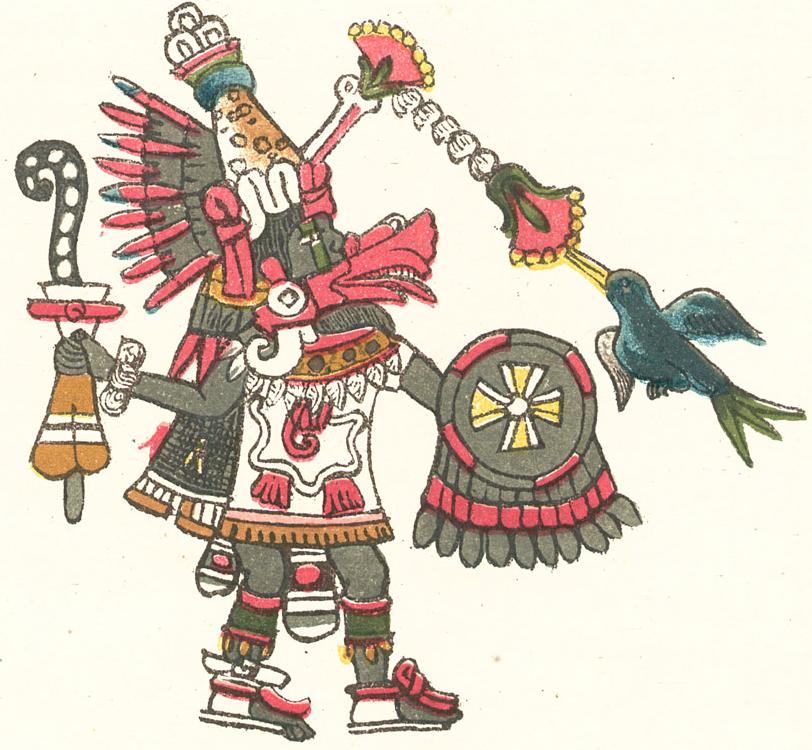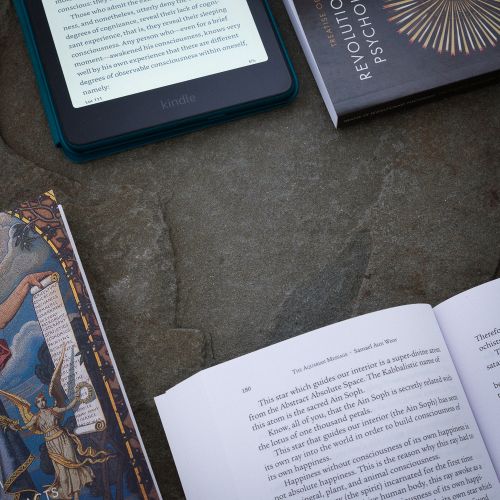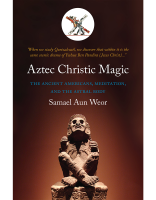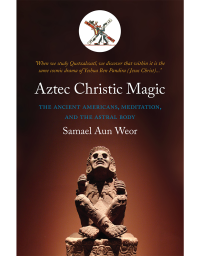Quetzalcoatl, Toltec god of the wind, third child of the divine couple Ometecuhtli and Omecihuatl,1 lord and lady of duality. Quetzalcoatl is represented with a silvery garment like the rays of Selene (the Moon). He wears a crescent moon on his chest and covers his face with a sacred mask. In his left hand he holds the chimalli, upon which the symbol of the dawning star is depicted. In his right hand he holds the macuahuitl for battle.

In another representation, this deity appears as the dawning star among the clouds. He carries a single sash on his waist, and on his back, there is a linen cloth with two crosses (each of the crossed arms equal in length). On one of his hieroglyphs, his head and ears appear as discs; on his nose, above his lip there hangs a disc; on his cheeks, there are three discs in the middle of each of which are drawn two Maltese crosses.
Quetzalcoatl is the Nahua Cosmic Christ, who incarnated in the home of Iztac Mixcóatl and Chimalmatl in the year Ce Acatl (895 CE). He had a mystical and austere disposition. When very young, he practiced fasting and penance. When he was thirty years old, he was named grand priest and monarch of Tollan (Tula, State of Hidalgo).
Another Toltec annal states:
“Exiled from his country, he returned to it after many years. From distant countries, he brought with him a very advanced civilization and a monotheistic religion of love for all human beings.”
Another of those chronicles states:
“Quetzalcoatl arrived to Tollan through Panuco; he was carried over the sea in a wooden vessel. He was fair skinned and bearded; he wore a tunic embroidered with little red crosses.”
As an instructor, the Nahuas represented Quetzalcoatl with a miter made of gold that was covered with a tiger skin and quetzalli feathers, along with an attractively adorned surplice and turquoise earrings. He had a necklace made from gold from which hung little tiny and precious marine shells. He wore a cape of quetzalli2 that resembled flames of fire, and cactli3 made of tiger skin from which also hung little marine shells; these little marine shells were held tight with very wide laces. These laces were then crisscrossed up the calf. In his left hand, he held shields, showing five-pointed stars in their centers, and in his right hand he held a scepter made out of gold which was engraved with precious stones.
Quetzalcoatl taught them how to farm the earth, how to classify the animals, how to carve precious stones, how to melt metals. He taught them about the goldsmith trade and about ceramics. Quetzalcoatl taught them about astronomy and how to use the calendar. He prohibited war. He taught them that they should sacrifice bread, flowers, and copalli4 instead of humans and animals. He prohibited homicide, thievery, polygamy, and any evil deed among human beings.
In Tollan, Quetzalcoatl founded a temple of mysteries with four great altars. The first altar was made of cedar wood with green ornaments. The second altar was made of cedar wood with coral ornaments. The third altar was made of cedar wood with marine shell ornaments. The fourth altar was made of cedar wood with ornaments of quetzalli feathers. Before these altars, Quetzalcoatl and his disciples prayed, fasted, and practiced penances.
Quetzalcoatl talked to them about Ipalnemohuani (He from whom we live), about the creation of the world, about the downfall of the human being, about the deluge, about Christ and his Gospel, about the baptism, about the circumcision, and about the cross (symbol of the immortality of life and of the redemption of humankind). Quetzalcoatl recommended that crosses be set upon the altars of the temples and in their homes. He named the countries, the mountains, and the valleys.
Quetzalcoatl was a divine instructor. He was denied and persecuted by the same people whom he had taught how to love and live. They persecuted him, and in his escape from Tollan, he sought refuge for some time in Teotihuacan (a place of worship) where he left behind an open temple. On this temple’s altar, the masters performed self-sacrifice and the solemn ceremony of the new fire.
The altar of this temple is adorned with serpents’ heads that are emerging from the calyx of a flower. This symbolizes Quetzalcoatl’s fall into the atomic human abysses. The white shells and the red snail shells that decorate these serpents’ heads are the emblem of the primary origin of this deity.
Quetzalcoatl passed from Teotihuacan to Cholula, where he lived for twenty years; however, because of a war, he had to flee from that place. He departed with four of his disciples to Coatzacoalcos. The annals state that he built a boat and entered the sea and disappeared. But before he left, he warned them that white, bearded men like himself would arrive from the sea to the east, and would take over Anahuac.
We know that this prophecy has been fulfilled; white, bearded men did come from the sea from the east; however, they did not come to evangelize with words, but rather by the sword. “Pray without rest so that ye can find the Lord with happiness instead of pain.”
In the Museum of Anthropology and History in Mexico City, as a testimony to the mystical teachings of Quetzalcoatl, there is a monolith with the figure of the precious serpent of quetzalli feathers. It has a great protruding cleft tongue (symbol of the light), and on top of the head a letter “I” (emblem of the fire, Ignis) and of the hieroglyph “acatl” (a cane), a water reed symbolized by the human head that completes the whole serpent’s body.
“Be ye therefore wise as serpents, and harmless as doves.” —Matthew 10:16
The precious serpent of quetzalli feathers is the symbol of the divine Nahua man, Quetzalcoatl, who incarnated in Adam and fell by yielding to the temptation of the biblical serpent.
For men, the summit of beauty is woman. Nature, music, flowers, a landscape, a child, emotionally stimulate us, yet a woman not only stimulates us, but attracts us, inspires us, provokes us. From childhood, we yearn for her tenderness because she is the other half of our being, and vice versa.
When we love during the connubial sexual act, we are like gods. The tlamatinime (philosophers, initiates) knew how to withdraw from the sexual act without spilling the seminal liquor. The solar and lunar hierarchies utilized a single spermatozoid to fecundate the woman.
The fallen angels were those who taught men and women how to ejaculate the seminal liquor. This is how they fell from their paradisiacal state into animality, within which, since then, they helplessly struggle. Therefore, may Quetzalcoatl, the divine, lovely, feathered (quetzalli) serpent (coatl), victoriously rise throughout their vertebral column again!
Because of the violation of the sixth commandment of the Law of God: “you shall not fornicate,” the quetzalli’s precious feathered serpent was modified, and when descending into the atomic abysses of man and woman, it had to writhe upon its belly through the mud of the earth because it became cursed (see Genesis 3:14).
This precious serpent of quetzalli feathers is enclosed within our seminal glands, and can only awaken and rise under the influence of amorous magic. This is also the Nahua’s emblem of the sacred fire of the Holy Spirit.5 When the Holy Spirit rises through the septuple canal of the spinal medulla, it converts us into angels.
On the stony patios of the temples of the Nahuas’ mysteries, couples (man and woman) remained for months and months, caressing each other and even sexually uniting without ever reaching the ejaculation of the seminal liquor. This is the how the Nahuas awoke in themselves the universal fire or the sacred fire of the Holy Spirit. This is how they converted themselves into magicians who made prodigies, such as the ones that were performed by the divine Master Jesus Christ during his time on the Earth.
Part of the teachings of this book is to teach how to transmute the human animalistic sexual forces into divine mental forces.
Man and woman, united by means of the natural use of their sex, will return to Eden. Love converts us into gods. When the precious serpent of quetzalli feathers rises through the vertebral column, it transforms itself into Quetzalcoatl, into the marvelous bird of all transformations, into the Minerva bird whose terrific secrets cannot be revealed by any initiate. Then, the sacred fire of the Holy Spirit flourishes upon our lips and is made Word. Under the influx of our word, the fire, the air, the water, and the earth will obey and adore us.
Practice
While resting on your bed, dorsal decubitus (on your back, facing up), relax all the muscles in your body, from the tip of your feet until the top of your head, and empty your mind for ten minutes.6 Afterwards, imagine that through your pineal gland (located almost exactly in the middle of your brain), the fire of the Holy Spirit descends from heaven and enters your body and revitalizes the marvelous chakra7 of this gland. Imagine that this chakra shines with its twelve central golden petals; an infinite number of multicolored petals are in the background, multicolored rays of light, petals of a marvelous lotus flower that moves from left to right (clockwise), as in a fiery whirl. This exercise must last for one hour and must be performed before you fall asleep.







